Case Study of Serena: Behavioral and Psychological Responses to Illness
VerifiedAdded on 2022/12/28
|10
|2679
|22
AI Summary
This report discusses the case study of Serena, who recovered from a fatal accident. It evaluates her behavioral and psychological responses to illness and provides recommendations to improve communication strategies in healthcare.
Contribute Materials
Your contribution can guide someone’s learning journey. Share your
documents today.
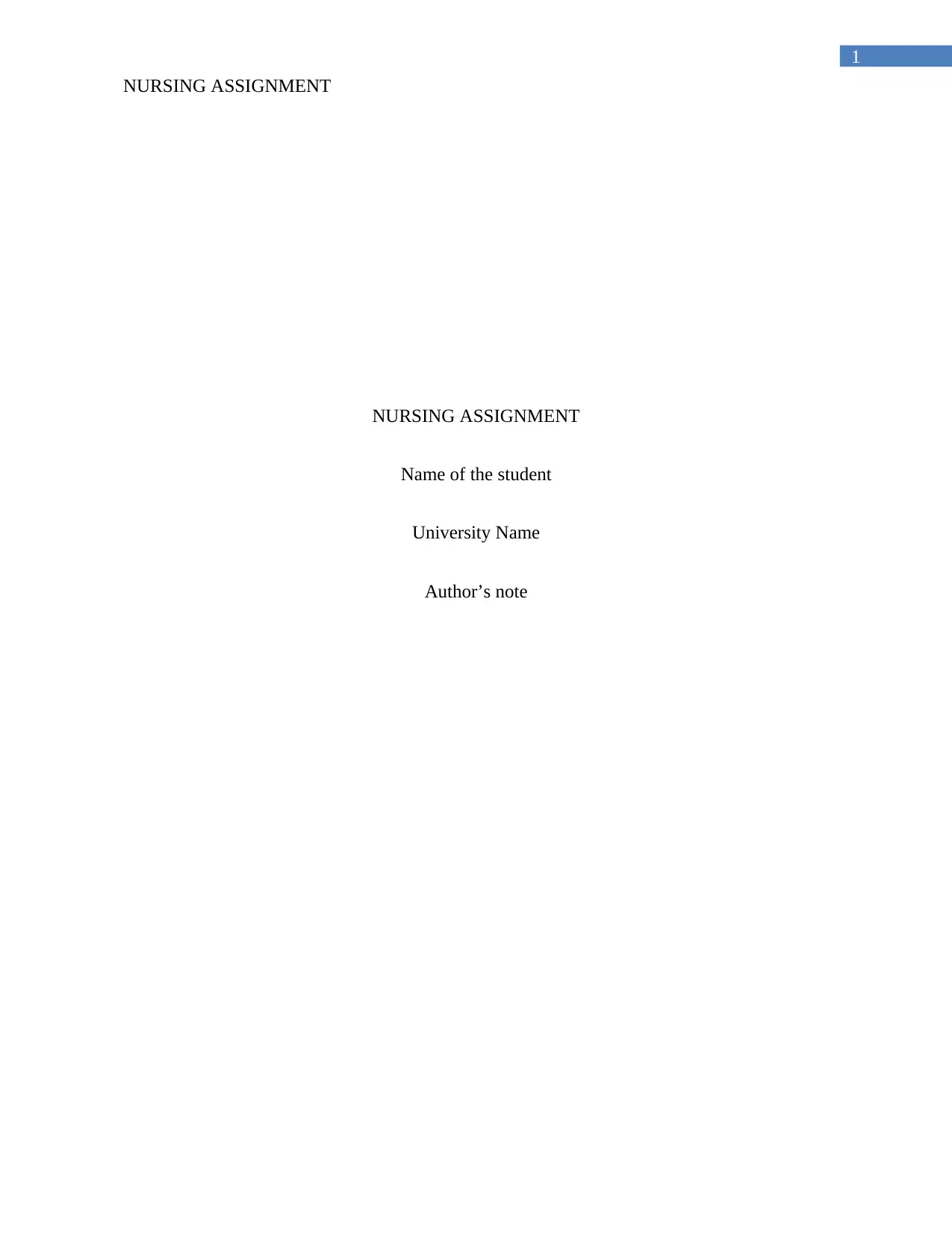
1
NURSING ASSIGNMENT
NURSING ASSIGNMENT
Name of the student
University Name
Author’s note
NURSING ASSIGNMENT
NURSING ASSIGNMENT
Name of the student
University Name
Author’s note
Secure Best Marks with AI Grader
Need help grading? Try our AI Grader for instant feedback on your assignments.
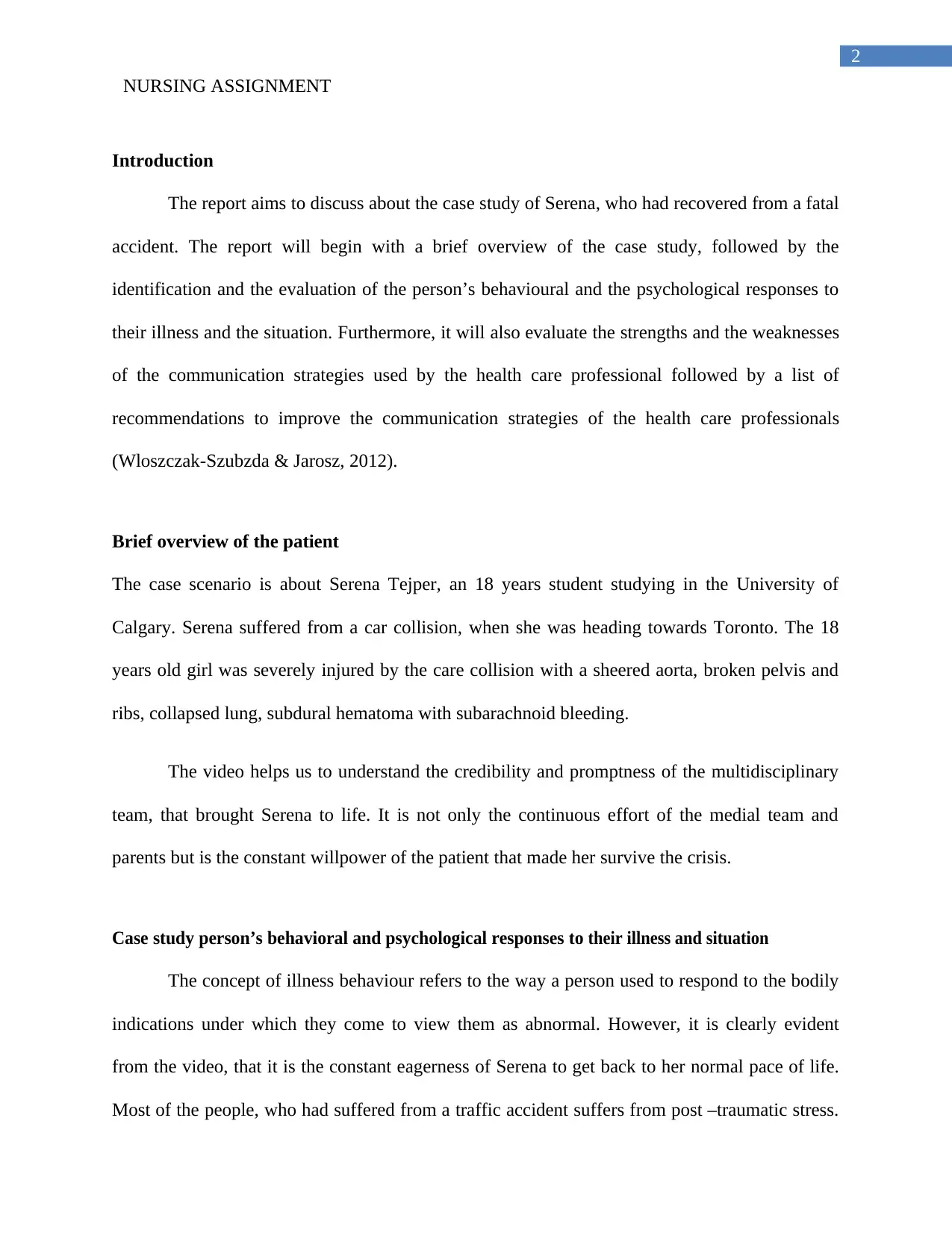
2
NURSING ASSIGNMENT
Introduction
The report aims to discuss about the case study of Serena, who had recovered from a fatal
accident. The report will begin with a brief overview of the case study, followed by the
identification and the evaluation of the person’s behavioural and the psychological responses to
their illness and the situation. Furthermore, it will also evaluate the strengths and the weaknesses
of the communication strategies used by the health care professional followed by a list of
recommendations to improve the communication strategies of the health care professionals
(Wloszczak-Szubzda & Jarosz, 2012).
Brief overview of the patient
The case scenario is about Serena Tejper, an 18 years student studying in the University of
Calgary. Serena suffered from a car collision, when she was heading towards Toronto. The 18
years old girl was severely injured by the care collision with a sheered aorta, broken pelvis and
ribs, collapsed lung, subdural hematoma with subarachnoid bleeding.
The video helps us to understand the credibility and promptness of the multidisciplinary
team, that brought Serena to life. It is not only the continuous effort of the medial team and
parents but is the constant willpower of the patient that made her survive the crisis.
Case study person’s behavioral and psychological responses to their illness and situation
The concept of illness behaviour refers to the way a person used to respond to the bodily
indications under which they come to view them as abnormal. However, it is clearly evident
from the video, that it is the constant eagerness of Serena to get back to her normal pace of life.
Most of the people, who had suffered from a traffic accident suffers from post –traumatic stress.
NURSING ASSIGNMENT
Introduction
The report aims to discuss about the case study of Serena, who had recovered from a fatal
accident. The report will begin with a brief overview of the case study, followed by the
identification and the evaluation of the person’s behavioural and the psychological responses to
their illness and the situation. Furthermore, it will also evaluate the strengths and the weaknesses
of the communication strategies used by the health care professional followed by a list of
recommendations to improve the communication strategies of the health care professionals
(Wloszczak-Szubzda & Jarosz, 2012).
Brief overview of the patient
The case scenario is about Serena Tejper, an 18 years student studying in the University of
Calgary. Serena suffered from a car collision, when she was heading towards Toronto. The 18
years old girl was severely injured by the care collision with a sheered aorta, broken pelvis and
ribs, collapsed lung, subdural hematoma with subarachnoid bleeding.
The video helps us to understand the credibility and promptness of the multidisciplinary
team, that brought Serena to life. It is not only the continuous effort of the medial team and
parents but is the constant willpower of the patient that made her survive the crisis.
Case study person’s behavioral and psychological responses to their illness and situation
The concept of illness behaviour refers to the way a person used to respond to the bodily
indications under which they come to view them as abnormal. However, it is clearly evident
from the video, that it is the constant eagerness of Serena to get back to her normal pace of life.
Most of the people, who had suffered from a traffic accident suffers from post –traumatic stress.
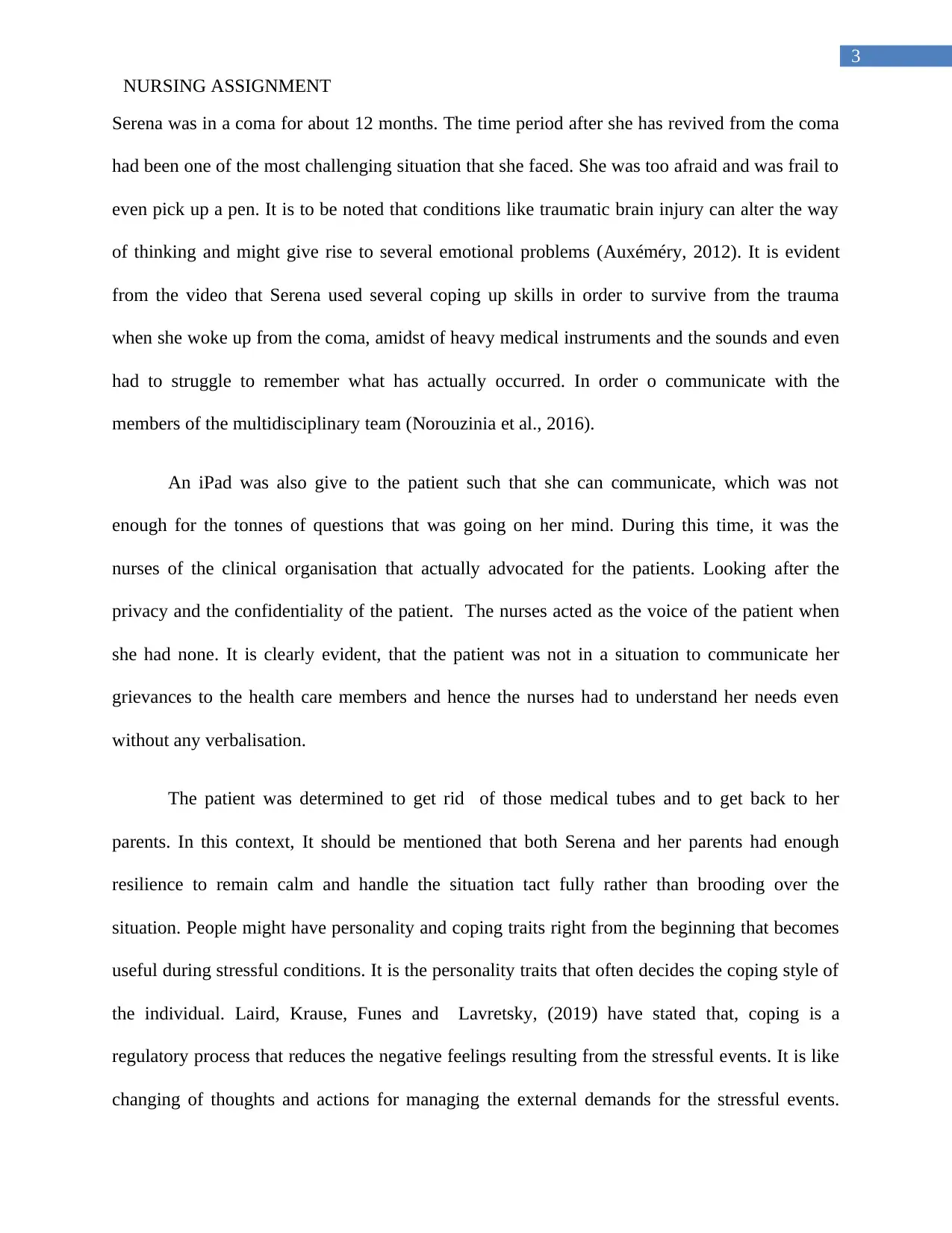
3
NURSING ASSIGNMENT
Serena was in a coma for about 12 months. The time period after she has revived from the coma
had been one of the most challenging situation that she faced. She was too afraid and was frail to
even pick up a pen. It is to be noted that conditions like traumatic brain injury can alter the way
of thinking and might give rise to several emotional problems (Auxéméry, 2012). It is evident
from the video that Serena used several coping up skills in order to survive from the trauma
when she woke up from the coma, amidst of heavy medical instruments and the sounds and even
had to struggle to remember what has actually occurred. In order o communicate with the
members of the multidisciplinary team (Norouzinia et al., 2016).
An iPad was also give to the patient such that she can communicate, which was not
enough for the tonnes of questions that was going on her mind. During this time, it was the
nurses of the clinical organisation that actually advocated for the patients. Looking after the
privacy and the confidentiality of the patient. The nurses acted as the voice of the patient when
she had none. It is clearly evident, that the patient was not in a situation to communicate her
grievances to the health care members and hence the nurses had to understand her needs even
without any verbalisation.
The patient was determined to get rid of those medical tubes and to get back to her
parents. In this context, It should be mentioned that both Serena and her parents had enough
resilience to remain calm and handle the situation tact fully rather than brooding over the
situation. People might have personality and coping traits right from the beginning that becomes
useful during stressful conditions. It is the personality traits that often decides the coping style of
the individual. Laird, Krause, Funes and Lavretsky, (2019) have stated that, coping is a
regulatory process that reduces the negative feelings resulting from the stressful events. It is like
changing of thoughts and actions for managing the external demands for the stressful events.
NURSING ASSIGNMENT
Serena was in a coma for about 12 months. The time period after she has revived from the coma
had been one of the most challenging situation that she faced. She was too afraid and was frail to
even pick up a pen. It is to be noted that conditions like traumatic brain injury can alter the way
of thinking and might give rise to several emotional problems (Auxéméry, 2012). It is evident
from the video that Serena used several coping up skills in order to survive from the trauma
when she woke up from the coma, amidst of heavy medical instruments and the sounds and even
had to struggle to remember what has actually occurred. In order o communicate with the
members of the multidisciplinary team (Norouzinia et al., 2016).
An iPad was also give to the patient such that she can communicate, which was not
enough for the tonnes of questions that was going on her mind. During this time, it was the
nurses of the clinical organisation that actually advocated for the patients. Looking after the
privacy and the confidentiality of the patient. The nurses acted as the voice of the patient when
she had none. It is clearly evident, that the patient was not in a situation to communicate her
grievances to the health care members and hence the nurses had to understand her needs even
without any verbalisation.
The patient was determined to get rid of those medical tubes and to get back to her
parents. In this context, It should be mentioned that both Serena and her parents had enough
resilience to remain calm and handle the situation tact fully rather than brooding over the
situation. People might have personality and coping traits right from the beginning that becomes
useful during stressful conditions. It is the personality traits that often decides the coping style of
the individual. Laird, Krause, Funes and Lavretsky, (2019) have stated that, coping is a
regulatory process that reduces the negative feelings resulting from the stressful events. It is like
changing of thoughts and actions for managing the external demands for the stressful events.
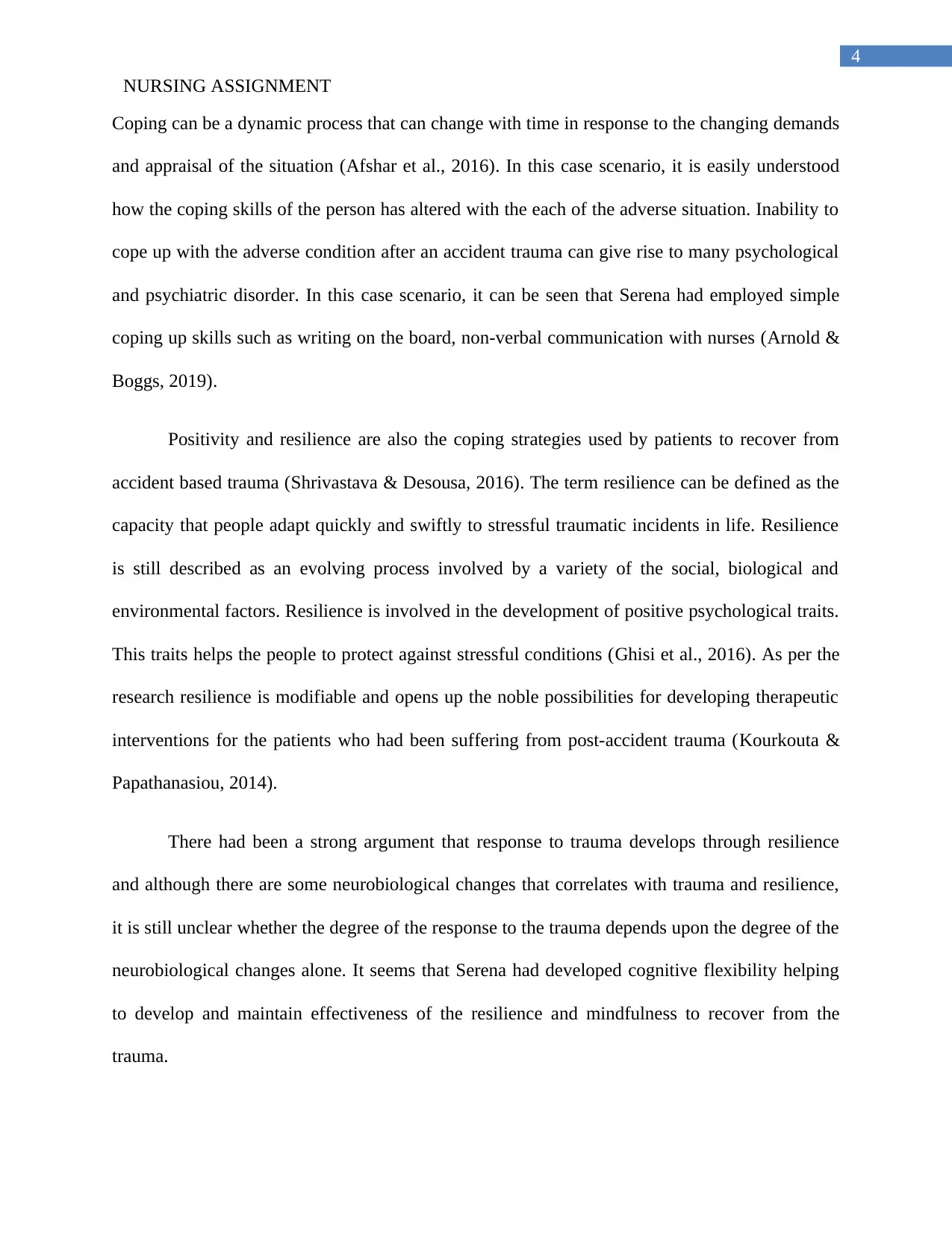
4
NURSING ASSIGNMENT
Coping can be a dynamic process that can change with time in response to the changing demands
and appraisal of the situation (Afshar et al., 2016). In this case scenario, it is easily understood
how the coping skills of the person has altered with the each of the adverse situation. Inability to
cope up with the adverse condition after an accident trauma can give rise to many psychological
and psychiatric disorder. In this case scenario, it can be seen that Serena had employed simple
coping up skills such as writing on the board, non-verbal communication with nurses (Arnold &
Boggs, 2019).
Positivity and resilience are also the coping strategies used by patients to recover from
accident based trauma (Shrivastava & Desousa, 2016). The term resilience can be defined as the
capacity that people adapt quickly and swiftly to stressful traumatic incidents in life. Resilience
is still described as an evolving process involved by a variety of the social, biological and
environmental factors. Resilience is involved in the development of positive psychological traits.
This traits helps the people to protect against stressful conditions (Ghisi et al., 2016). As per the
research resilience is modifiable and opens up the noble possibilities for developing therapeutic
interventions for the patients who had been suffering from post-accident trauma (Kourkouta &
Papathanasiou, 2014).
There had been a strong argument that response to trauma develops through resilience
and although there are some neurobiological changes that correlates with trauma and resilience,
it is still unclear whether the degree of the response to the trauma depends upon the degree of the
neurobiological changes alone. It seems that Serena had developed cognitive flexibility helping
to develop and maintain effectiveness of the resilience and mindfulness to recover from the
trauma.
NURSING ASSIGNMENT
Coping can be a dynamic process that can change with time in response to the changing demands
and appraisal of the situation (Afshar et al., 2016). In this case scenario, it is easily understood
how the coping skills of the person has altered with the each of the adverse situation. Inability to
cope up with the adverse condition after an accident trauma can give rise to many psychological
and psychiatric disorder. In this case scenario, it can be seen that Serena had employed simple
coping up skills such as writing on the board, non-verbal communication with nurses (Arnold &
Boggs, 2019).
Positivity and resilience are also the coping strategies used by patients to recover from
accident based trauma (Shrivastava & Desousa, 2016). The term resilience can be defined as the
capacity that people adapt quickly and swiftly to stressful traumatic incidents in life. Resilience
is still described as an evolving process involved by a variety of the social, biological and
environmental factors. Resilience is involved in the development of positive psychological traits.
This traits helps the people to protect against stressful conditions (Ghisi et al., 2016). As per the
research resilience is modifiable and opens up the noble possibilities for developing therapeutic
interventions for the patients who had been suffering from post-accident trauma (Kourkouta &
Papathanasiou, 2014).
There had been a strong argument that response to trauma develops through resilience
and although there are some neurobiological changes that correlates with trauma and resilience,
it is still unclear whether the degree of the response to the trauma depends upon the degree of the
neurobiological changes alone. It seems that Serena had developed cognitive flexibility helping
to develop and maintain effectiveness of the resilience and mindfulness to recover from the
trauma.
Secure Best Marks with AI Grader
Need help grading? Try our AI Grader for instant feedback on your assignments.
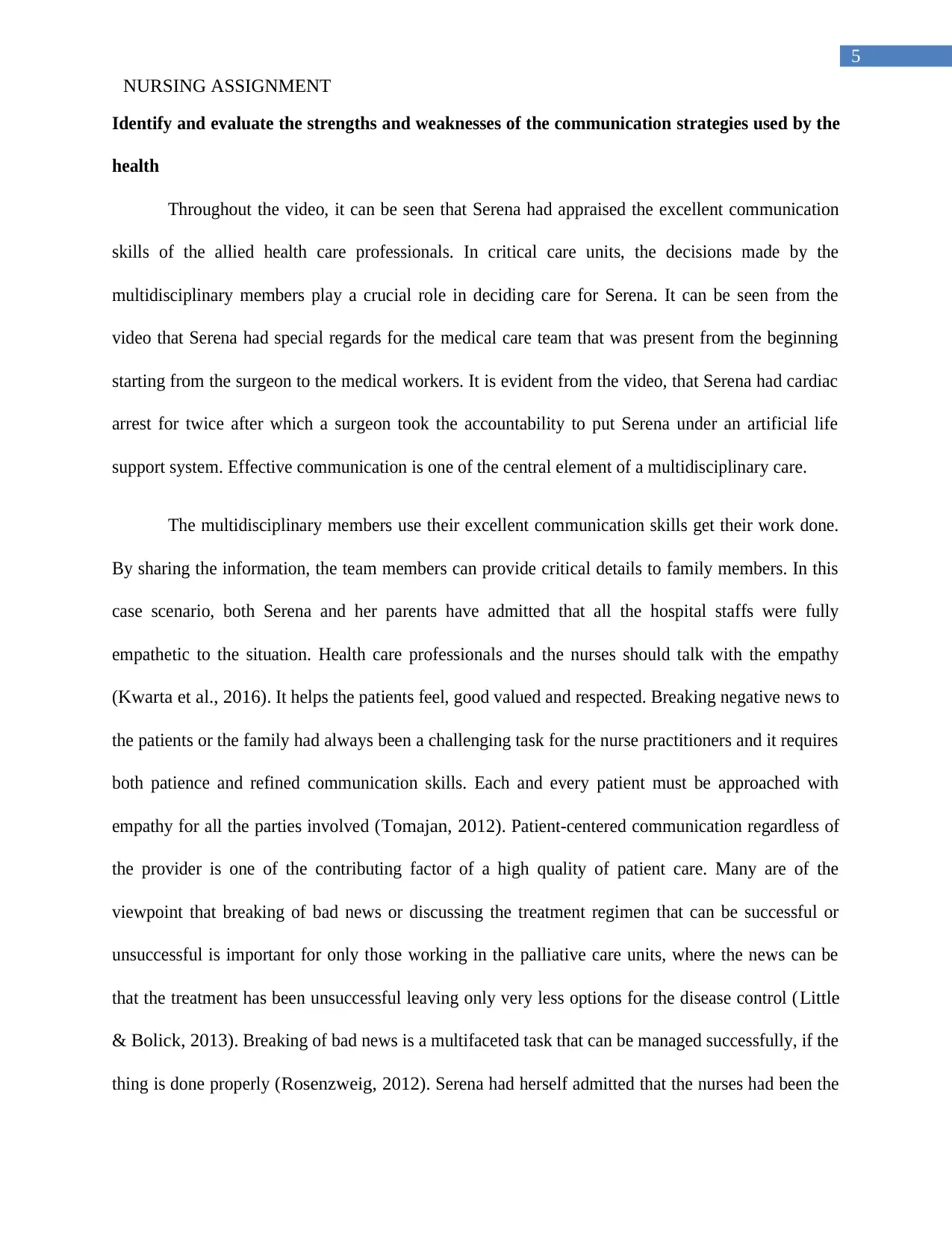
5
NURSING ASSIGNMENT
Identify and evaluate the strengths and weaknesses of the communication strategies used by the
health
Throughout the video, it can be seen that Serena had appraised the excellent communication
skills of the allied health care professionals. In critical care units, the decisions made by the
multidisciplinary members play a crucial role in deciding care for Serena. It can be seen from the
video that Serena had special regards for the medical care team that was present from the beginning
starting from the surgeon to the medical workers. It is evident from the video, that Serena had cardiac
arrest for twice after which a surgeon took the accountability to put Serena under an artificial life
support system. Effective communication is one of the central element of a multidisciplinary care.
The multidisciplinary members use their excellent communication skills get their work done.
By sharing the information, the team members can provide critical details to family members. In this
case scenario, both Serena and her parents have admitted that all the hospital staffs were fully
empathetic to the situation. Health care professionals and the nurses should talk with the empathy
(Kwarta et al., 2016) . It helps the patients feel, good valued and respected. Breaking negative news to
the patients or the family had always been a challenging task for the nurse practitioners and it requires
both patience and refined communication skills. Each and every patient must be approached with
empathy for all the parties involved (Tomajan, 2012) . Patient-centered communication regardless of
the provider is one of the contributing factor of a high quality of patient care. Many are of the
viewpoint that breaking of bad news or discussing the treatment regimen that can be successful or
unsuccessful is important for only those working in the palliative care units, where the news can be
that the treatment has been unsuccessful leaving only very less options for the disease control (Little
& Bolick, 2013) . Breaking of bad news is a multifaceted task that can be managed successfully, if the
thing is done properly (Rosenzweig, 2012) . Serena had herself admitted that the nurses had been the
NURSING ASSIGNMENT
Identify and evaluate the strengths and weaknesses of the communication strategies used by the
health
Throughout the video, it can be seen that Serena had appraised the excellent communication
skills of the allied health care professionals. In critical care units, the decisions made by the
multidisciplinary members play a crucial role in deciding care for Serena. It can be seen from the
video that Serena had special regards for the medical care team that was present from the beginning
starting from the surgeon to the medical workers. It is evident from the video, that Serena had cardiac
arrest for twice after which a surgeon took the accountability to put Serena under an artificial life
support system. Effective communication is one of the central element of a multidisciplinary care.
The multidisciplinary members use their excellent communication skills get their work done.
By sharing the information, the team members can provide critical details to family members. In this
case scenario, both Serena and her parents have admitted that all the hospital staffs were fully
empathetic to the situation. Health care professionals and the nurses should talk with the empathy
(Kwarta et al., 2016) . It helps the patients feel, good valued and respected. Breaking negative news to
the patients or the family had always been a challenging task for the nurse practitioners and it requires
both patience and refined communication skills. Each and every patient must be approached with
empathy for all the parties involved (Tomajan, 2012) . Patient-centered communication regardless of
the provider is one of the contributing factor of a high quality of patient care. Many are of the
viewpoint that breaking of bad news or discussing the treatment regimen that can be successful or
unsuccessful is important for only those working in the palliative care units, where the news can be
that the treatment has been unsuccessful leaving only very less options for the disease control (Little
& Bolick, 2013) . Breaking of bad news is a multifaceted task that can be managed successfully, if the
thing is done properly (Rosenzweig, 2012) . Serena had herself admitted that the nurses had been the
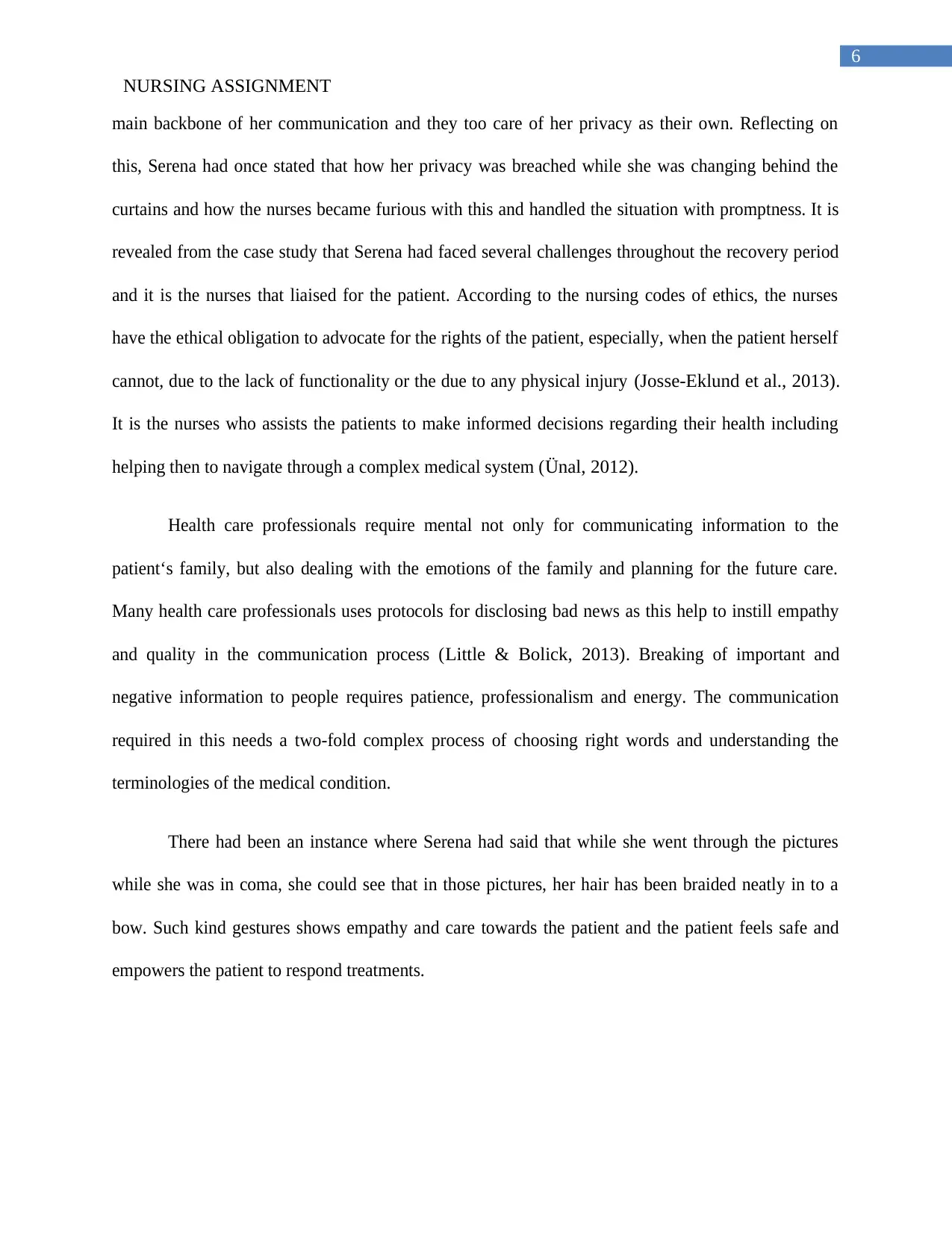
6
NURSING ASSIGNMENT
main backbone of her communication and they too care of her privacy as their own. Reflecting on
this, Serena had once stated that how her privacy was breached while she was changing behind the
curtains and how the nurses became furious with this and handled the situation with promptness. It is
revealed from the case study that Serena had faced several challenges throughout the recovery period
and it is the nurses that liaised for the patient. According to the nursing codes of ethics, the nurses
have the ethical obligation to advocate for the rights of the patient, especially, when the patient herself
cannot, due to the lack of functionality or the due to any physical injury (Josse-Eklund et al., 2013) .
It is the nurses who assists the patients to make informed decisions regarding their health including
helping then to navigate through a complex medical system (Ünal, 2012) .
Health care professionals require mental not only for communicating information to the
patient‘s family, but also dealing with the emotions of the family and planning for the future care.
Many health care professionals uses protocols for disclosing bad news as this help to instill empathy
and quality in the communication process (Little & Bolick, 2013) . Breaking of important and
negative information to people requires patience, professionalism and energy. The communication
required in this needs a two-fold complex process of choosing right words and understanding the
terminologies of the medical condition.
There had been an instance where Serena had said that while she went through the pictures
while she was in coma, she could see that in those pictures, her hair has been braided neatly in to a
bow. Such kind gestures shows empathy and care towards the patient and the patient feels safe and
empowers the patient to respond treatments.
NURSING ASSIGNMENT
main backbone of her communication and they too care of her privacy as their own. Reflecting on
this, Serena had once stated that how her privacy was breached while she was changing behind the
curtains and how the nurses became furious with this and handled the situation with promptness. It is
revealed from the case study that Serena had faced several challenges throughout the recovery period
and it is the nurses that liaised for the patient. According to the nursing codes of ethics, the nurses
have the ethical obligation to advocate for the rights of the patient, especially, when the patient herself
cannot, due to the lack of functionality or the due to any physical injury (Josse-Eklund et al., 2013) .
It is the nurses who assists the patients to make informed decisions regarding their health including
helping then to navigate through a complex medical system (Ünal, 2012) .
Health care professionals require mental not only for communicating information to the
patient‘s family, but also dealing with the emotions of the family and planning for the future care.
Many health care professionals uses protocols for disclosing bad news as this help to instill empathy
and quality in the communication process (Little & Bolick, 2013) . Breaking of important and
negative information to people requires patience, professionalism and energy. The communication
required in this needs a two-fold complex process of choosing right words and understanding the
terminologies of the medical condition.
There had been an instance where Serena had said that while she went through the pictures
while she was in coma, she could see that in those pictures, her hair has been braided neatly in to a
bow. Such kind gestures shows empathy and care towards the patient and the patient feels safe and
empowers the patient to respond treatments.
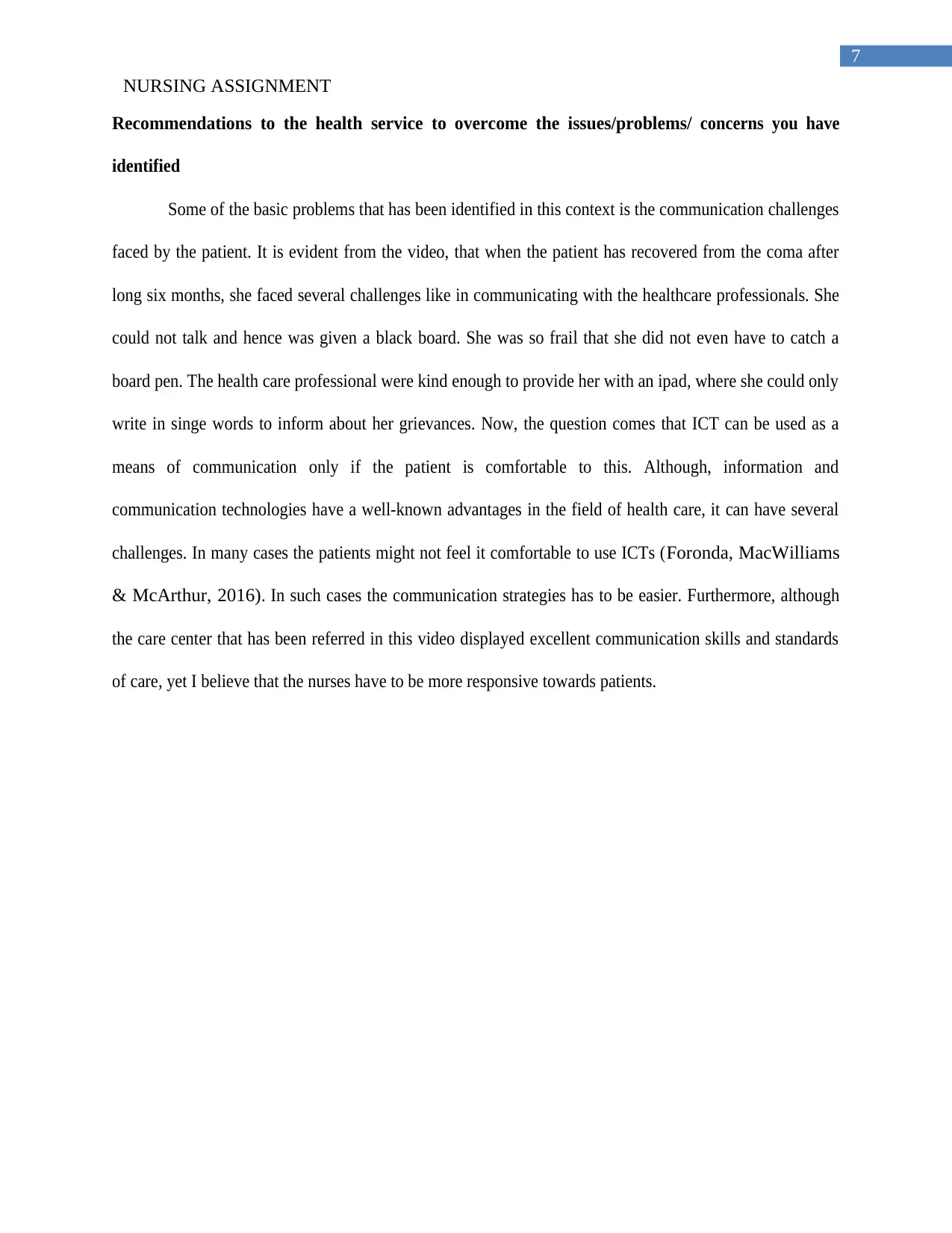
7
NURSING ASSIGNMENT
Recommendations to the health service to overcome the issues/problems/ concerns you have
identified
Some of the basic problems that has been identified in this context is the communication challenges
faced by the patient. It is evident from the video, that when the patient has recovered from the coma after
long six months, she faced several challenges like in communicating with the healthcare professionals. She
could not talk and hence was given a black board. She was so frail that she did not even have to catch a
board pen. The health care professional were kind enough to provide her with an ipad, where she could only
write in singe words to inform about her grievances. Now, the question comes that ICT can be used as a
means of communication only if the patient is comfortable to this. Although, information and
communication technologies have a well-known advantages in the field of health care, it can have several
challenges. In many cases the patients might not feel it comfortable to use ICTs (Foronda, MacWilliams
& McArthur, 2016) . In such cases the communication strategies has to be easier. Furthermore, although
the care center that has been referred in this video displayed excellent communication skills and standards
of care, yet I believe that the nurses have to be more responsive towards patients.
NURSING ASSIGNMENT
Recommendations to the health service to overcome the issues/problems/ concerns you have
identified
Some of the basic problems that has been identified in this context is the communication challenges
faced by the patient. It is evident from the video, that when the patient has recovered from the coma after
long six months, she faced several challenges like in communicating with the healthcare professionals. She
could not talk and hence was given a black board. She was so frail that she did not even have to catch a
board pen. The health care professional were kind enough to provide her with an ipad, where she could only
write in singe words to inform about her grievances. Now, the question comes that ICT can be used as a
means of communication only if the patient is comfortable to this. Although, information and
communication technologies have a well-known advantages in the field of health care, it can have several
challenges. In many cases the patients might not feel it comfortable to use ICTs (Foronda, MacWilliams
& McArthur, 2016) . In such cases the communication strategies has to be easier. Furthermore, although
the care center that has been referred in this video displayed excellent communication skills and standards
of care, yet I believe that the nurses have to be more responsive towards patients.
Paraphrase This Document
Need a fresh take? Get an instant paraphrase of this document with our AI Paraphraser
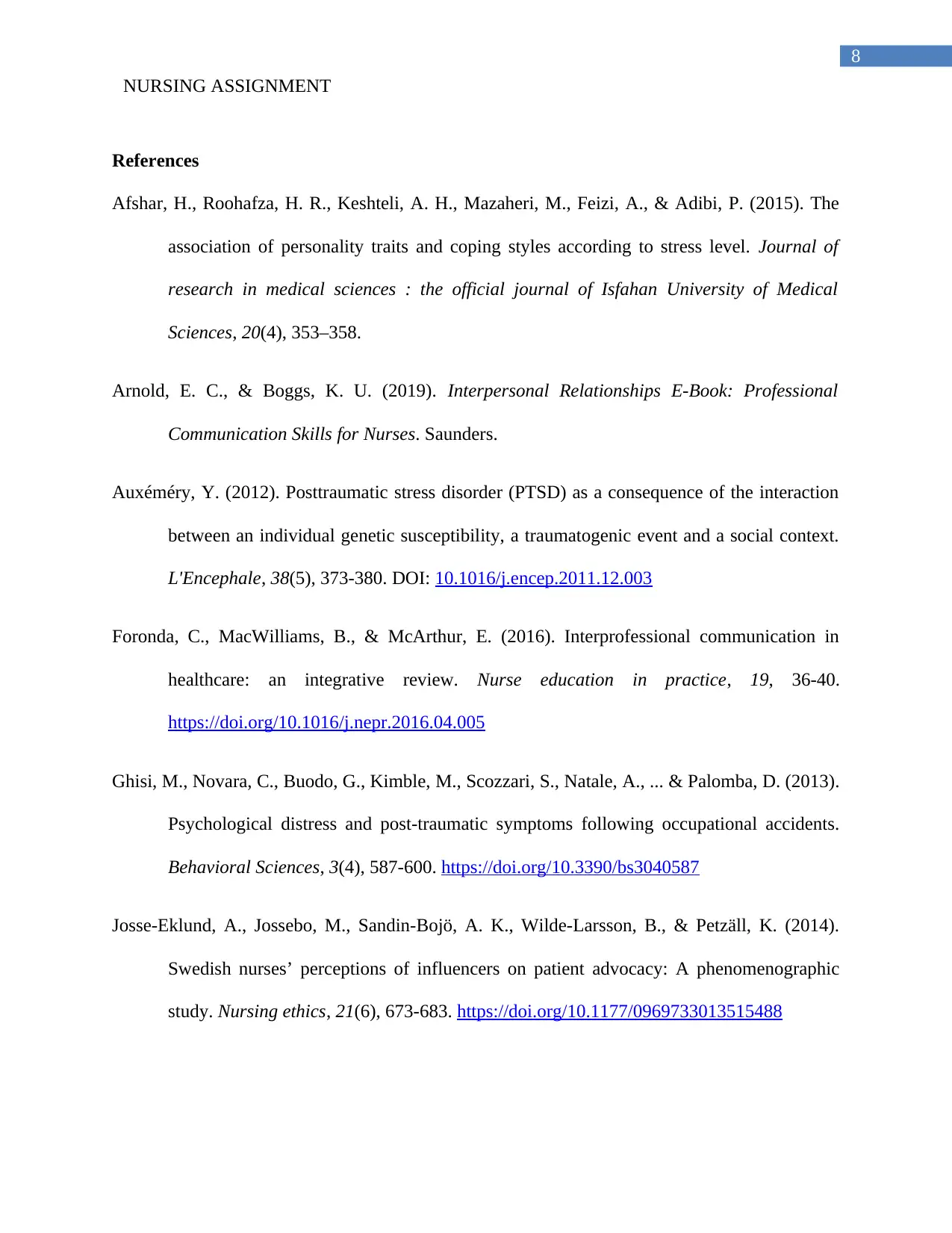
8
NURSING ASSIGNMENT
References
Afshar, H., Roohafza, H. R., Keshteli, A. H., Mazaheri, M., Feizi, A., & Adibi, P. (2015). The
association of personality traits and coping styles according to stress level. Journal of
research in medical sciences : the official journal of Isfahan University of Medical
Sciences, 20(4), 353–358.
Arnold, E. C., & Boggs, K. U. (2019). Interpersonal Relationships E-Book: Professional
Communication Skills for Nurses. Saunders.
Auxéméry, Y. (2012). Posttraumatic stress disorder (PTSD) as a consequence of the interaction
between an individual genetic susceptibility, a traumatogenic event and a social context.
L'Encephale, 38(5), 373-380. DOI: 10.1016/j.encep.2011.12.003
Foronda, C., MacWilliams, B., & McArthur, E. (2016). Interprofessional communication in
healthcare: an integrative review. Nurse education in practice, 19, 36-40.
https://doi.org/10.1016/j.nepr.2016.04.005
Ghisi, M., Novara, C., Buodo, G., Kimble, M., Scozzari, S., Natale, A., ... & Palomba, D. (2013).
Psychological distress and post-traumatic symptoms following occupational accidents.
Behavioral Sciences, 3(4), 587-600. https://doi.org/10.3390/bs3040587
Josse-Eklund, A., Jossebo, M., Sandin-Bojö, A. K., Wilde-Larsson, B., & Petzäll, K. (2014).
Swedish nurses’ perceptions of influencers on patient advocacy: A phenomenographic
study. Nursing ethics, 21(6), 673-683. https://doi.org/10.1177/0969733013515488
NURSING ASSIGNMENT
References
Afshar, H., Roohafza, H. R., Keshteli, A. H., Mazaheri, M., Feizi, A., & Adibi, P. (2015). The
association of personality traits and coping styles according to stress level. Journal of
research in medical sciences : the official journal of Isfahan University of Medical
Sciences, 20(4), 353–358.
Arnold, E. C., & Boggs, K. U. (2019). Interpersonal Relationships E-Book: Professional
Communication Skills for Nurses. Saunders.
Auxéméry, Y. (2012). Posttraumatic stress disorder (PTSD) as a consequence of the interaction
between an individual genetic susceptibility, a traumatogenic event and a social context.
L'Encephale, 38(5), 373-380. DOI: 10.1016/j.encep.2011.12.003
Foronda, C., MacWilliams, B., & McArthur, E. (2016). Interprofessional communication in
healthcare: an integrative review. Nurse education in practice, 19, 36-40.
https://doi.org/10.1016/j.nepr.2016.04.005
Ghisi, M., Novara, C., Buodo, G., Kimble, M., Scozzari, S., Natale, A., ... & Palomba, D. (2013).
Psychological distress and post-traumatic symptoms following occupational accidents.
Behavioral Sciences, 3(4), 587-600. https://doi.org/10.3390/bs3040587
Josse-Eklund, A., Jossebo, M., Sandin-Bojö, A. K., Wilde-Larsson, B., & Petzäll, K. (2014).
Swedish nurses’ perceptions of influencers on patient advocacy: A phenomenographic
study. Nursing ethics, 21(6), 673-683. https://doi.org/10.1177/0969733013515488
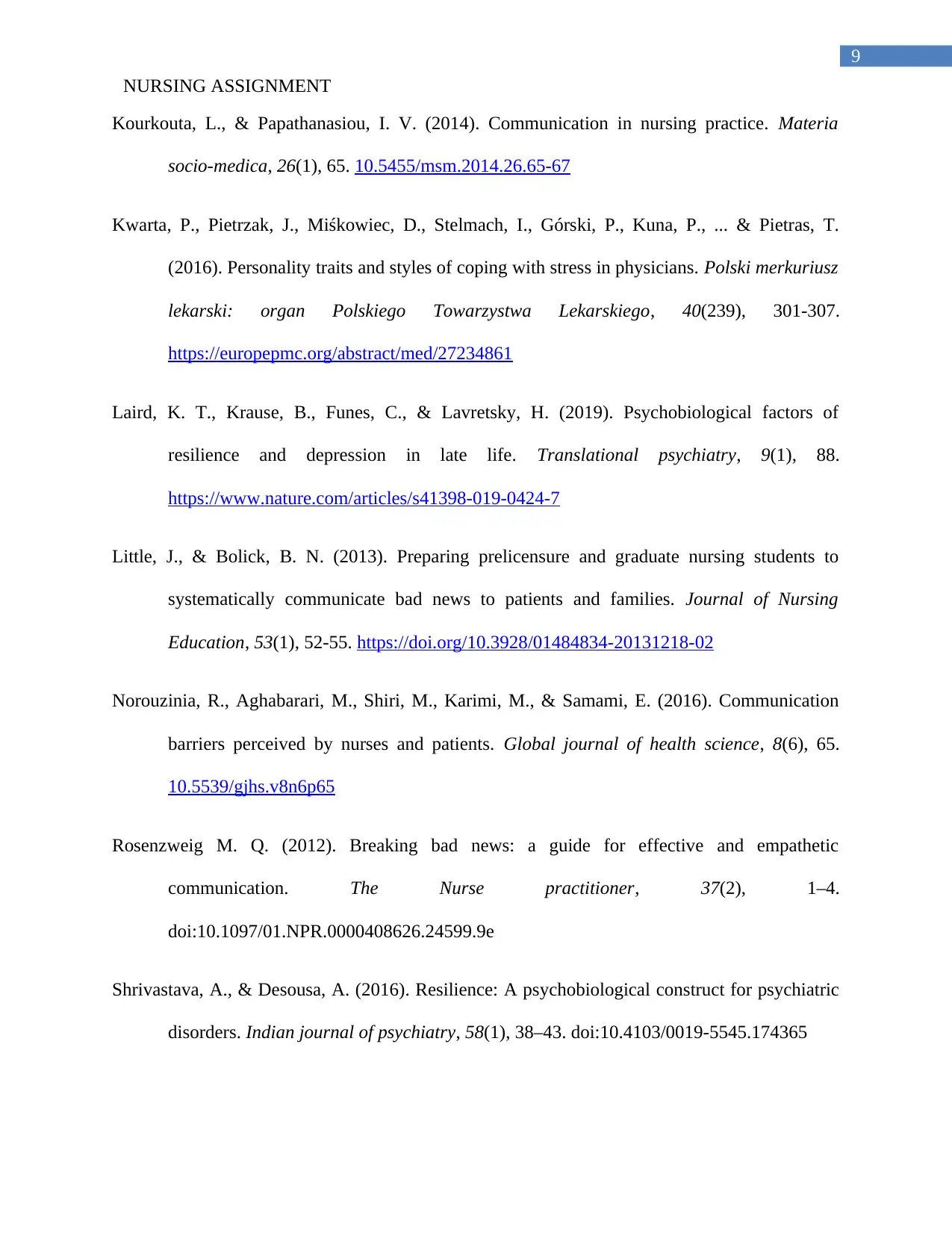
9
NURSING ASSIGNMENT
Kourkouta, L., & Papathanasiou, I. V. (2014). Communication in nursing practice. Materia
socio-medica, 26(1), 65. 10.5455/msm.2014.26.65-67
Kwarta, P., Pietrzak, J., Miśkowiec, D., Stelmach, I., Górski, P., Kuna, P., ... & Pietras, T.
(2016). Personality traits and styles of coping with stress in physicians. Polski merkuriusz
lekarski: organ Polskiego Towarzystwa Lekarskiego, 40(239), 301-307.
https://europepmc.org/abstract/med/27234861
Laird, K. T., Krause, B., Funes, C., & Lavretsky, H. (2019). Psychobiological factors of
resilience and depression in late life. Translational psychiatry, 9(1), 88.
https://www.nature.com/articles/s41398-019-0424-7
Little, J., & Bolick, B. N. (2013). Preparing prelicensure and graduate nursing students to
systematically communicate bad news to patients and families. Journal of Nursing
Education, 53(1), 52-55. https://doi.org/10.3928/01484834-20131218-02
Norouzinia, R., Aghabarari, M., Shiri, M., Karimi, M., & Samami, E. (2016). Communication
barriers perceived by nurses and patients. Global journal of health science, 8(6), 65.
10.5539/gjhs.v8n6p65
Rosenzweig M. Q. (2012). Breaking bad news: a guide for effective and empathetic
communication. The Nurse practitioner, 37(2), 1–4.
doi:10.1097/01.NPR.0000408626.24599.9e
Shrivastava, A., & Desousa, A. (2016). Resilience: A psychobiological construct for psychiatric
disorders. Indian journal of psychiatry, 58(1), 38–43. doi:10.4103/0019-5545.174365
NURSING ASSIGNMENT
Kourkouta, L., & Papathanasiou, I. V. (2014). Communication in nursing practice. Materia
socio-medica, 26(1), 65. 10.5455/msm.2014.26.65-67
Kwarta, P., Pietrzak, J., Miśkowiec, D., Stelmach, I., Górski, P., Kuna, P., ... & Pietras, T.
(2016). Personality traits and styles of coping with stress in physicians. Polski merkuriusz
lekarski: organ Polskiego Towarzystwa Lekarskiego, 40(239), 301-307.
https://europepmc.org/abstract/med/27234861
Laird, K. T., Krause, B., Funes, C., & Lavretsky, H. (2019). Psychobiological factors of
resilience and depression in late life. Translational psychiatry, 9(1), 88.
https://www.nature.com/articles/s41398-019-0424-7
Little, J., & Bolick, B. N. (2013). Preparing prelicensure and graduate nursing students to
systematically communicate bad news to patients and families. Journal of Nursing
Education, 53(1), 52-55. https://doi.org/10.3928/01484834-20131218-02
Norouzinia, R., Aghabarari, M., Shiri, M., Karimi, M., & Samami, E. (2016). Communication
barriers perceived by nurses and patients. Global journal of health science, 8(6), 65.
10.5539/gjhs.v8n6p65
Rosenzweig M. Q. (2012). Breaking bad news: a guide for effective and empathetic
communication. The Nurse practitioner, 37(2), 1–4.
doi:10.1097/01.NPR.0000408626.24599.9e
Shrivastava, A., & Desousa, A. (2016). Resilience: A psychobiological construct for psychiatric
disorders. Indian journal of psychiatry, 58(1), 38–43. doi:10.4103/0019-5545.174365
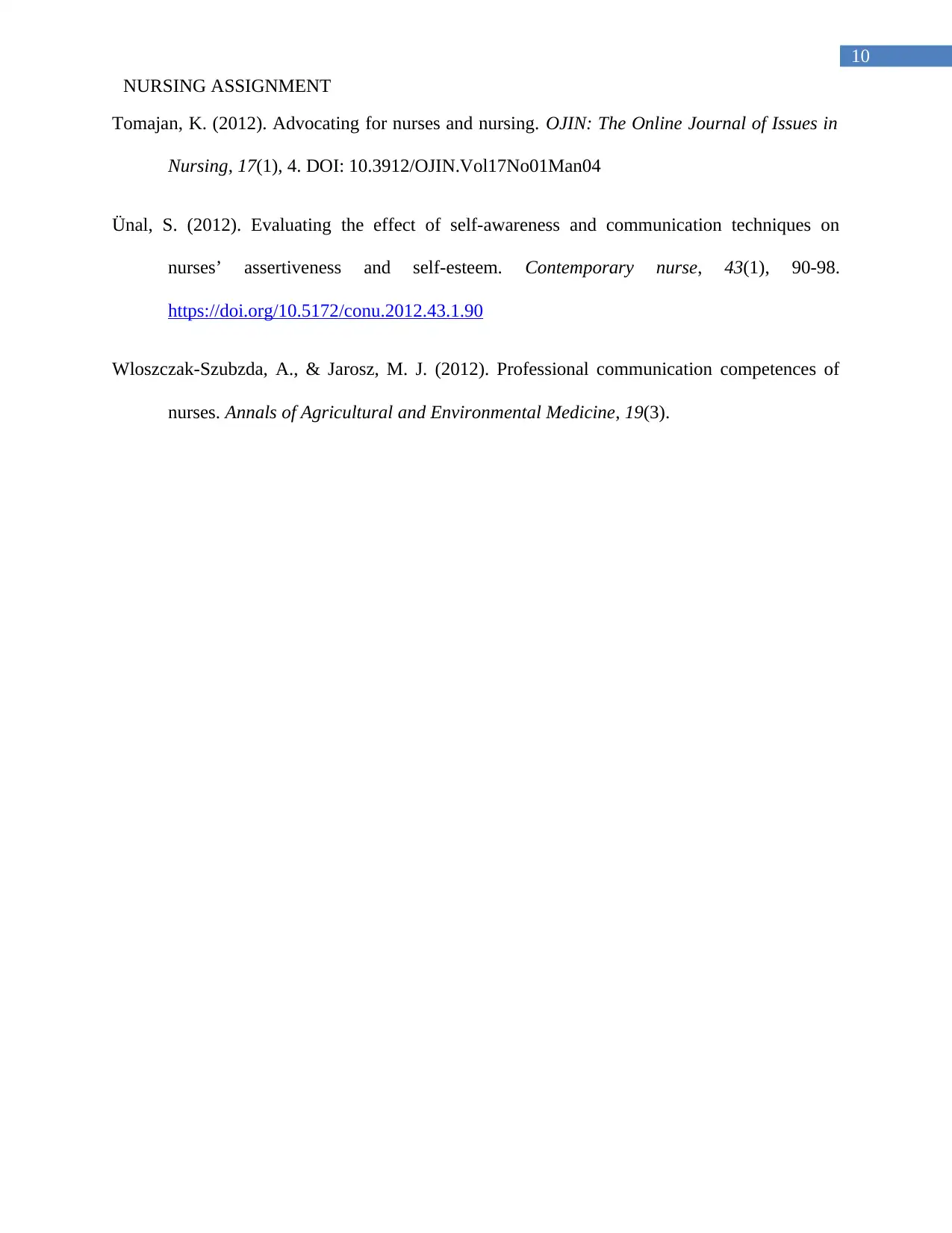
10
NURSING ASSIGNMENT
Tomajan, K. (2012). Advocating for nurses and nursing. OJIN: The Online Journal of Issues in
Nursing, 17(1), 4. DOI: 10.3912/OJIN.Vol17No01Man04
Ünal, S. (2012). Evaluating the effect of self-awareness and communication techniques on
nurses’ assertiveness and self-esteem. Contemporary nurse, 43(1), 90-98.
https://doi.org/10.5172/conu.2012.43.1.90
Wloszczak-Szubzda, A., & Jarosz, M. J. (2012). Professional communication competences of
nurses. Annals of Agricultural and Environmental Medicine, 19(3).
NURSING ASSIGNMENT
Tomajan, K. (2012). Advocating for nurses and nursing. OJIN: The Online Journal of Issues in
Nursing, 17(1), 4. DOI: 10.3912/OJIN.Vol17No01Man04
Ünal, S. (2012). Evaluating the effect of self-awareness and communication techniques on
nurses’ assertiveness and self-esteem. Contemporary nurse, 43(1), 90-98.
https://doi.org/10.5172/conu.2012.43.1.90
Wloszczak-Szubzda, A., & Jarosz, M. J. (2012). Professional communication competences of
nurses. Annals of Agricultural and Environmental Medicine, 19(3).
1 out of 10
Related Documents
Your All-in-One AI-Powered Toolkit for Academic Success.
+13062052269
info@desklib.com
Available 24*7 on WhatsApp / Email
![[object Object]](/_next/static/media/star-bottom.7253800d.svg)
Unlock your academic potential
© 2024 | Zucol Services PVT LTD | All rights reserved.





